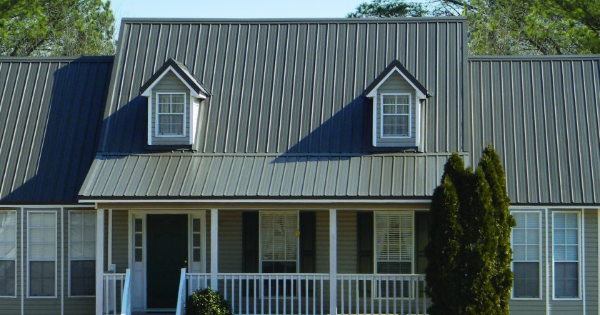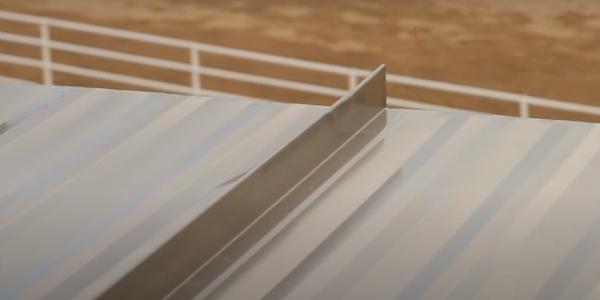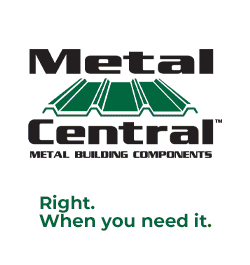UP TO THE MINUTE
How to Ensure a Successful Metal Roof Installation

By Brian Haraf, Metal Sales.
Tips and tricks to know before taking on your next metal roof installation job.
Did you know that environmentally conscious consumers are driving up demand for metal roofing? Durable materials like steel with a self-healing zinc coating can withstand environmental exposure for 50 years or more — delivering exceptional value.
However, not all metal roofs are equal. The quality of the materials and craftsmanship during installation, along with the details of the construction, can all impact performance. A successful metal roof installation requires knowledge and skill. Let’s take a look at what you can do to ensure a successful metal roof installation for your clients.
Roofing considerations
A metal roof is a common choice for a replacement roof, especially for homeowners looking to take advantage of the sustainable benefits like reflective coatings that reduce energy use to heat and cool a home. Whether it’s a replacement roof or a new construction, the roof should be engineered with the specific construction in mind.
Contractors and roof installation pros should take the time to communicate the specific energy-efficient benefits that their roofing materials can provide. This value-add message gets homeowners fully onboard, simplifying your sales approach so that you can spend more time focusing on the installation.
Waterproofing
Steel is not the most effective waterproofing material. Since moisture is one of the biggest problems a home can experience, additional waterproofing measures are necessary before installing a metal roof.
In most cases, a polyurethane compound is applied to the metal, providing full adhesion with generous elasticity to add a waterproofing element to the metal panels. However, there are other less expensive options. Cheaper products might use liquid rubber instead of polyurethane. Or, they might simply use a silicone-based sealant. Each product provides varying degrees of moisture protection to prevent roof leaks.
This is another area that is commonly misunderstood by homeowners looking to take advantage of metal roofing. Contractors and installers can ensure success by choosing roofing products with the most effective water shedding and waterproofing capabilities.
Roof slope
Shallow roofs with a low slope can take too long to shed water, leaving a buildup of moisture that can lead to premature failure. A slope is a measure of height versus length, indicating how steep or flat the roof is. For metal, the minimum pitch is 3:12. Anything less than that, and the roof is too flat. As a knowledgeable contractor, taking the time to pair the right materials with the right roofs is the first step toward a successful roof installation.
Adhesive
If you have ever tried to use the wrong glue on a project, like wood glue for a plastic piece, you’ve experienced adhesion incompatibility. Different chemicals have different abilities to bond with materials. With the chemical composition of roofing adhesives varying by formula, compatibility is a significant issue that can impact the weather-resistant performance of a metal roof.
Attention to detail, especially when it comes to adhesives and finishes, can make the difference between a satisfied customer and a drain on the wallet. As a roofing contractor, there is no detail too small — your success depends on how well each component works together to provide long-lasting durability.
Roof penetrations
Ideally, there should be minimal disruptions to the surface of a roof. Each time that a chimney, pipe, or drain is vented through the roof, there needs to be an opening in the metal panel to accommodate the penetration. Each penetration presents another opportunity for leaks. A quality roof installation requires careful inspection and quality workmanship. Take the time to address each roof penetration, ensuring that your client’s home will be safe from leaks for years to come by using the proper finishing pieces and adhesives to protect every vulnerability.
Project preparation
Choosing the right materials for the job is only half the battle. Everything still needs to be installed with knowledge and expertise to ensure a successful roof. Build your expertise by focusing on:
- Experience
- Knowledge and training
- Permitting
- Job site preparation
- Tools and materials
- Measurements
Build your team and put together a thorough process that demonstrates quality roofing services to prospective clients. To do this, you should work on achieving industry certifications and acknowledgments from leading manufacturers to bolster your credibility. Collect reviews from past clients and share good feedback to provide as much exposure as possible.
Be prepared for potential clients to ask open-ended questions. You should be able to walk anyone through your installation process without hesitation. From job site preparation to the final inspection, let clients know what to expect before work begins.
The project preparation should occur on-site and include a firsthand look at the structure with detailed measurements. Each metal roof installation should be a unique project. While your skills and expertise translate from one job to the next, how you apply that knowledge varies based on unique factors. Your ability to do the latter can make the difference between a successful metal roof installation and a project that falls flat of the customers' expectations.
Installing the roof
A metal roof installation is a job for qualified professionals. From ordering enough materials to proper substrate preparation and panel placement, there is a lot that can go wrong during installation. Even small, barely noticeable gaps can lead to big moisture problems.
Here’s a quick look at the process for replacing a roof:
- Removal of old roofing materials
- Repair of damaged areas
- Installation of insulation
- Edging installation
- Metal panel installation
- Add flashing pieces
- Finish inspection
Often, a metal roof is a replacement that is installed over existing asphalt shingles or a wood substrate. Both are acceptable for installing a metal roof as long as you take the time to properly prepare the surface before installing the metal roof.
Any damaged area in the existing roof should be repaired first to ensure that old problems aren’t causing new problems once the metal roof is in place. Then, the roof installation should be worked in steps to ensure that each panel is placed and secured properly and each penetration is sealed with flashing.
Once everything is in place, take the time to meticulously inspect your work and ensure that there are no gaps between panels, edging and flashing pieces.
Tips for installing a successful metal roof
A metal roof can be a durable, long-lasting and energy-efficient alternative to traditional asphalt roofing. However, a successful metal roof depends on quality materials and installation. Here are a few tips that can help make your project a success.
- Avoid installing rivets in valleys. Each hold drilled is a potential for a future leak. That risk is compounded if the rivets are placed where water naturally pools.
- Be mindful of using exposed fasteners. The possibility of a leak is more significant with exposed fasteners, especially when a fastener is pinned through the flat portion of the panel.
- Don’t double-pin roof panels. This is a misguided attempt to ensure stability. In reality, it prevents necessary expansion and contraction with weather conditions, leading to premature failure.
- Don’t leave exposed edges. Trim and flashing are more than an aesthetic finish; they provide necessary protection around the edges that can prevent panels from lifting or leaking.
- Be attentive to installing appropriate flashing around all penetration. Even small gaps caused by these seams can lead to big problems.
The takeaway on getting a successful metal roof installation
Metal roofing can be a great choice for commercial and residential buildings alike. However, there are noticeable quality differences in materials and installation that can impact individual experiences. Set yourself up for success by providing clients with quality workmanship, attentive service and clear communication from start to finish.
Learn more about Metal Sales in their directory or visit www.metalsales.us.com.
About Brian Haraf
Brian Haraf is the VP of Sales and Marketing at Metal Sales Manufacturing Corporation. With 21 facilities nationwide, Metal Sales manufactures metal roof and wall panels for the agricultural, commercial, architectural and residential markets since 1963.


















Comments
Leave a Reply
Have an account? Login to leave a comment!
Sign In